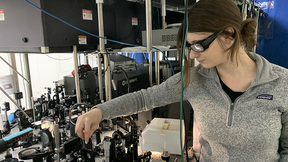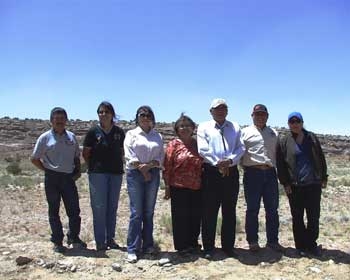Lab assists Navajo Nation in monitoring uranium sites
Scientists from LLNL assisted the Navajo Abandoned Mine Lands Reclamation Program (NAMLRP) in developing an environmental uranium monitoring station at the Tse Tah Morrison site south of Red Mesa, Ariz. The monitoring station is the first of its kind used for characterizing the more than 1,000 abandoned uranium sites on the Navajo Nation land.
Navajo Nation President Ben Shelly mentioned that it is important to protect the public. "I am impressed with the Laboratory and the NAMLRP in their partnership to address this difficult work," he said.
Several LLNL experts in uranium radiochemistry, geochemistry and hydrogeology are providing assistance to the NAMLRP within the Navajo Nation Division of Natural Resources, in characterizing and monitoring uranium waste disposal landfills and uranium contaminated sites in the Navajo Nation.
"This pilot project is the first step in providing monitoring sensors for abandoned mines sites," said Steve Grey, Laboratory program manager.
The Lab's lead technical team includes Michael Taffet, Vic Madrid and Brad Esser. This project will focus on developing an environmental monitoring system for a uranium mine waste disposal landfill currently being constructed at the Tse Tah Morrison abandoned mine lands site.
The LLNL team also may review several other uranium contaminated sites on tribal trust lands, including abandoned mine sites and surrounding areas. These areas are a legacy of post-World War II uranium mining. This project is the culmination of interactions between NAMLRP and LLNL that began in 2008 focusing on the nature of uranium contaminated sites within the Navajo Nation and their potential for adverse impacts on water resources, human health and the environment.
The LLNL team is qualified to provide assistance in this area -- they have performed assessment and remediation of uranium contamination at a number of sites, including several LLNL sites in similar hydrogeological settings, and have capabilities that are unique in the DOE Complex and in the United States for uranium characterization. This initiative is being funded by NAMLRP.
LLNL is providing technical guidance to NAMRLP in installing moisture sensors connected to data loggers at multiple depths within the Morrison waster cell to verify the effectiveness of the overall design in preventing leaching of the buried waste. LLNL also is assisting NAMLRP in designing a protocol and applying it for characterizing abandoned uranium mine sites, including the use of a field detector for quantify uranium content in soils in real time.
Funding for this pilot project is provided by the Department of Interior Office of Surface Mining for the Navajo Nation.
Contact
Linda A Lucchetti[email protected]
925-422-5815
Tags
ScienceFeatured Articles









